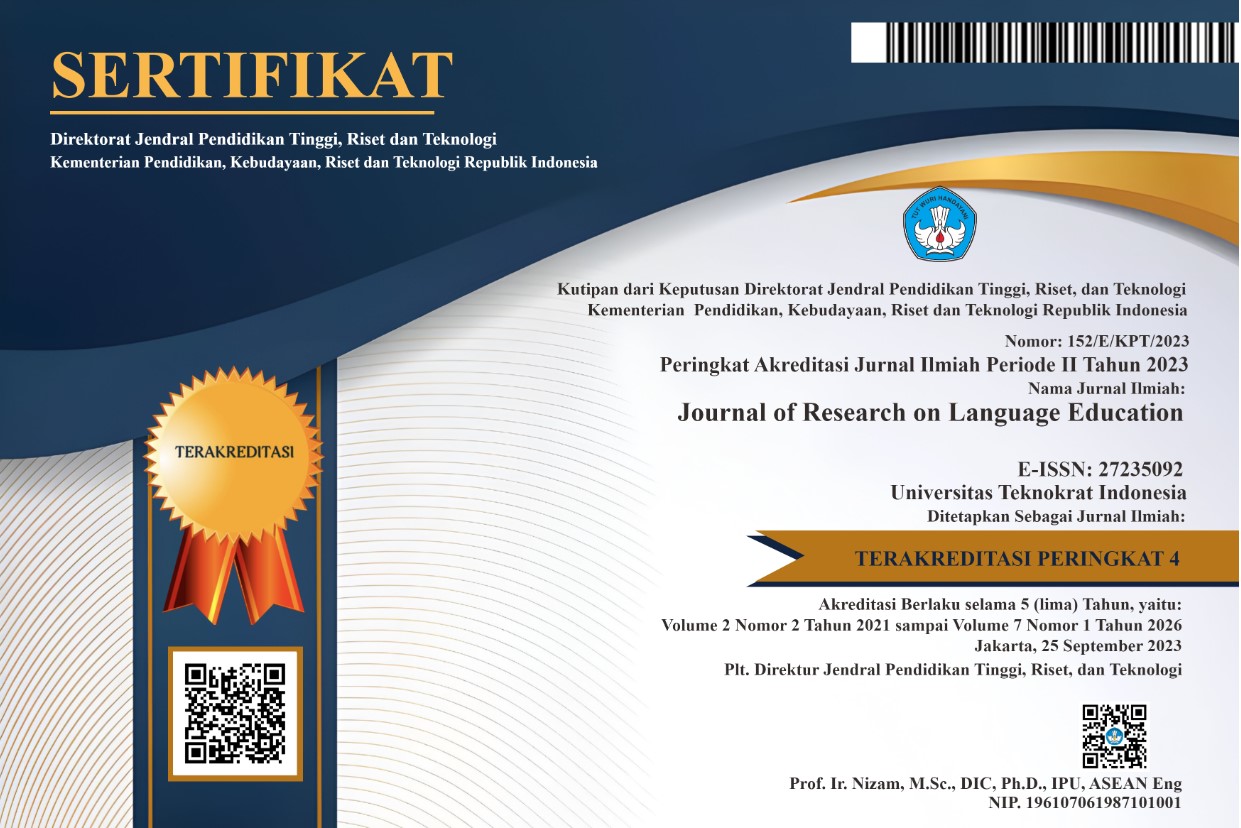EXPLORING THE LEVEL AND PRIMARY CAUSES OF PUBLIC SPEAKING ANXIETY AMONG ENGLISH DEPARTMENT STUDENTS
Abstract
English public speaking anxiety is a crucial issue experienced by students and it needs to be coped with acknowledging the importance of public speaking proficiency concerning today's demands. As EFL students, many studies have found that they encountered a considerable level of public speaking anxiety in which significantly affects their speaking quality. Therefore, measuring students' public speaking anxiety is essential since it can help both the students and teachers to know the level and primary causes of public speaking anxiety so that effective strategies can be designed to overcome this particular issue. Hence, the researchers attempt to investigate the level and primary causes of EFL students' public speaking anxiety. This present study participated by 34 third-semester students of the English Department at Universitas Tidar. In collecting the data regarding the public speaking anxiety level, the researchers used the Public Speaking Class Anxiety Scale (PSCAS) proposed by Yaikhong & Usaha (2012). Furthermore, the results from the questionnaire are delineated to explore the causes of public speaking anxiety. The study found that 58.8% of students experienced a medium level of public speaking anxiety. In addition, most of the students agreed that fear of negative evaluation becomes the major anxiety-provoking factor following by communication apprehension and test anxiety—lastly, only almost half of the students’ experience comfort in speaking English.
Keywords
Full Text:
PDFReferences
Aliaga, M., & Gunderson, B. (2002). Interactive Statistics. Thousand Oaks: Sage.
Astuti, K. N. (2011). Jurus Kilat Jago Public Speaking Secara Otodidak,. Laskar Aksara.
Aydin, S. (2016). A Qualitative Research on Foreign Language Teaching Anxiety. The Qualitative Report, 21(4), 629–642.
Baccarani, C., & Bonfanti, A. (2015). Effective public speaking: A conceptual framework in the corporate-communication field. Corporate Communications: An International Journal, 20(3), 375–390.
Bashosh, S., Nejad, M. A., Rastegar, M., & Marzban, A. (2013). The relationship between shyness, foreign language classroom anxiety, willingness to communicate, gender, and EFL proficiency. Theory and Practice in Language Studies, 3(11), 2098–2106. https://doi.org/https://doi.org/10.4304/tpls.3.11.2098-2106
Beebe, S. A., & Beebe, S. J. (2013). Public Speaking Handbook (4th Edition). Pearson.
Bodie, G. (2010). A racing heart, rattling knees, and ruminative thoughts: Defining, explaining, and treating public speaking anxiety. Communication Education, 59(1), 70–105.
Boonkit, K. (2010). Enhancing the Development of Speaking Skills for Non-Native Speakers of English. Procedia Social and Behavioral Sciences, 2(2010), 1305–1309.
Davidson, J. (2002). The Complete Guide to Public Speaking. John Wiley & Sons, Inc.
DeVito, J. A. (1986). The Interpersonal Communication Book (4th ed.). Harper and Row Publishers.
Gregersen, T., & Horwitz, E. K. (2002). Language learning and perfectionism: Anxious and non-anxious language learners’ reactions to their own oral performance. Modern Language Journal, 86(4), 562–570. https://doi.org/https://doi.org/10.1111/1540-4781.00161
Hanna, M. S., & Gibson, J. W. (1992). Public speaking for personal success (3rd ed). William C. Brown.
Hidayoza, P., Amri, Z., & Wahyuni, D. (2019). Level of Public Speaking Anxiety and Coping Strategy used by English Debaters at Unit Kegiatan Bahasa Asing in dealing with English Debate. 8(1).
Horwitz, E. K., & Young, D. (1991). Language Learning Anxiety: From Theory and Research to Classroom Implications. Prentice-Hall.
Horwitz, E. K., Horwitz, M. B., & Cope, J. (1986). Foreign Language Classroom Anxiety. In Source: The Modern Language Journal (Vol. 70, Issue 2).
Katz, L. (2000). Public Speaking Anxiety. In UTM Counseling and Career Services (Vol. 1). University of Tennessee. http://sp.myconcorde.edu/sites/Portland-OR/LRC/Shared Documents/Public Speaking.pdf
Kurniawanti, B. St. (2017). A Study of Anxiety in Speaking Class of the Second Semester Students in English Education Department at UIN Alauddin Makassar. Undergraduate (S1) thesis, Universitas Islam Negeri Alauddin Makassar.
Leong, L. M., & Ahmadi, S. M. (2017). An analysis of factors influencing learners’ English speaking skill. International Journal of Research in English Education, 2(1), 34–4.
MacIntyre, P. D., & Gardner, R. C. (1994). The Subtle Effects of Language Anxiety on Cognitive Processing in the Second Language. Language Learning, 44(2), 283–305. https://doi.org/10.1111/j.1467-1770.1994.tb01103.x
Mak, B. (2011). An exploration of speaking-in-class anxiety with Chinese ESL learners. System, 39(2), 202–214.
Melouah, A. (2013). Foreign language anxiety in EFL speaking classrooms: A case study of first-year LMD students of English at Saad Dahlab University of Blida, Algeria. Arab World English Journal, 4(1), 64–76.
Novaković, N., & Teodosijević, B. (2017). Basics of public speaking. Bizinfo Blace, 8(2), 33–46. https://doi.org/10.5937/bizinfo1702033n
Park, H., & Lee, A. R. (2005). L2 learners’ anxiety, self-confidence and oral performance. The 10th Conference of Pan-Pacific Asso-Ciation of Applied Linguistics, Japan.
Peplau, H. E. (1989). Anxiety, Self, and Hallucination. In Interpersonal theory in Nursing Practice. Springer.
Pratama, R. (2018). A Student ’s strategies to overcome Speaking Anxiety in Public Speaking Class.
Pratiwi, I. A., Mirizon, S., & Zuraida. (2017). An analysis on students’ perception toward their speaking anxiety of English Education Study Program at Sriwijaya University. 2007, 334–342.
Rachmawati, D. I., & Jurianto, J. (2020). Investigating English Department Students’ Foreign Language Speaking Anxiety: a Case Study in Universitas Airlangga, Indonesia. Social Sciences, Humanities and Education Journal (SHE Journal), 1(2), 22. https://doi.org/10.25273/she.v1i2.6624
Rowh, M. (2009). Speak out! Everyone can benefit from public speaking skills. Career World, a Weekly Reader Publication, 38(3), 6-9.
Sadiq, J. M. (2017). Anxiety in English Language Learning: A Case Study of English Language Learners in Saudi Arabia. English Language Teaching, 10(7), 1. https://doi.org/10.5539/elt.v10n7p1
Sikandar, A. (2017). Anxiety Level in Students of Public Speaking: Causes and Remedies. Journal of Education and Educational Development, 4(1), 94–110.
Spijck, B. V. (2011). Overcoming fear of public speaking. https://coachcampus.com/coach-portfolios/research-papers/%0Ajoana-reis-an-approach-for-coaches/
Sugiyono. (2005). Memahami Penelitian Kualitatif. Alfabeta.
Sulastiani. (2017). Students’ perception toward Psychological Problems faced in Public Speaking Class of English Department. Muhammadiyah University of Makassar.
Suleimenova, Z. (2012). Speaking anxiety in a Kazakhstani foreign language classroom. Sino-US English Teaching, 9(12), 1766–1774.
Tiyas, A., Nurhidayah, Y., & Herdiawan., R. D. (2020). “Why I can’t speak up?”: Students’ Anxiety in Public Speaking. Journal of English Language Learning (JELL), 103.
Toubot, A. M., Hock Seng, G., & Binti Atan Abdullah, A. (2018). Examining Levels and Factors of Speaking Anxiety among EFL Libyan English Undergraduate Students. International Journal of Applied Linguistics and English Literature, 7(5), 47. https://doi.org/10.7575/aiac.ijalel.v.7n.5p.47
Yaikhong, K., & Usaha, S. (2012). A Measure of EFL Public Speaking Class Anxiety : Scale Development and Preliminary Validation and Reliability. 5(12), 23–35. https://doi.org/10.5539/elt.v5n12p23
Young, D. J. (1991). Creating a low‐anxiety classroom environment: What does language Anxiety Research Suggest? The Modern Language Journal, 75(4), 426–437.
Young, Dolly J. (1999). A Perspective on foreign language learning: From body to mind to emotion. In Affect in foreign language and second language learning (Young, D.). McGraw-Hill.
Zia, Z., & Norrihan, S. (2015). EFL learners’ levels of class -room performance anxieties and their causes in class-room speaking activities in Afghanistan. International Journal of English and Education, 4(1), 239–249.
DOI: https://doi.org/10.33365/jorle.v2i1.906
Refbacks
- There are currently no refbacks.

This work is licensed under a Creative Commons Attribution-NonCommercial-ShareAlike 4.0 International License.

Articles published in Journal of Research on Language Education is licensed
under a Creative Commons Attribution-ShareAlike 4.0 International License.
English Education Study Program, Faculty of Arts and Education.
Universitas Teknokrat Indonesia
Zainal Abidin Pagaralam 9-11 Bandar Lampung, Indonesia
All rights reserved.








